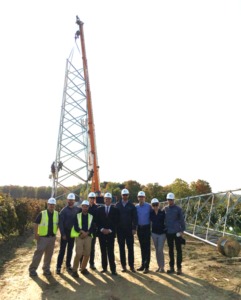As part of his continued efforts to fight for domestic energy security, Rep. Tom Reed, R-N.Y., recently paid a visit to United Wind’s turbine construction site on a local wind farm in Ripley, N.Y.
During the visit, Reed reviewed the construction of wind energy turbines at the Knight Farm while meeting with local employees and area leaders to discuss the importance of his bipartisan bill, the Technologies for Energy Security Act, which extends the investment tax credit (ITC).
The ITC encourages the use of residential and commercial wind electrical generation systems by offsetting some of the cost of installation. The congressman notes that by harnessing the power of the wind, families and small businesses can drive their utility costs down and protect the environment. Without the passage of the legislation, the tax credit will expire in 2016.
“We care about ensuring America’s energy security for the sake of the hardworking men and women from across our region and future generations,” says Reed. “It’s only right that we support local efforts to take advantage of innovative technologies that help meet our energy needs. These pioneers will lead the way and cultivate the investment we need to implement these technologies on a much wider scale.”
Russell Tencer, founder and CEO of United Wind, says he was thrilled to host Congressman Reed.

“Distributed wind makes sense for homeowners, farmers and business owners who want to save money on their electricity bill, and it plays a small part in ensuring homegrown, on-site power generation for Americans,” Tencer says. “We are pleased to know that Congressman Reed is fighting for wind energy to play a key role in the future of how we power our country.
“Using all available resources – especially our renewable resources, like the wind – to meet our energy needs is [a] critical part of our plan for America’s energy future,” adds Reed.
Last year, Reed issued his “Plan for America’s Energy future,” a comprehensive plan designed to create U.S. energy security. The plan focuses on using all available resources, modernizing energy delivery systems, ending overregulation, and helping the American workforce fill jobs in the energy sector with the appropriate workforce training and development.




